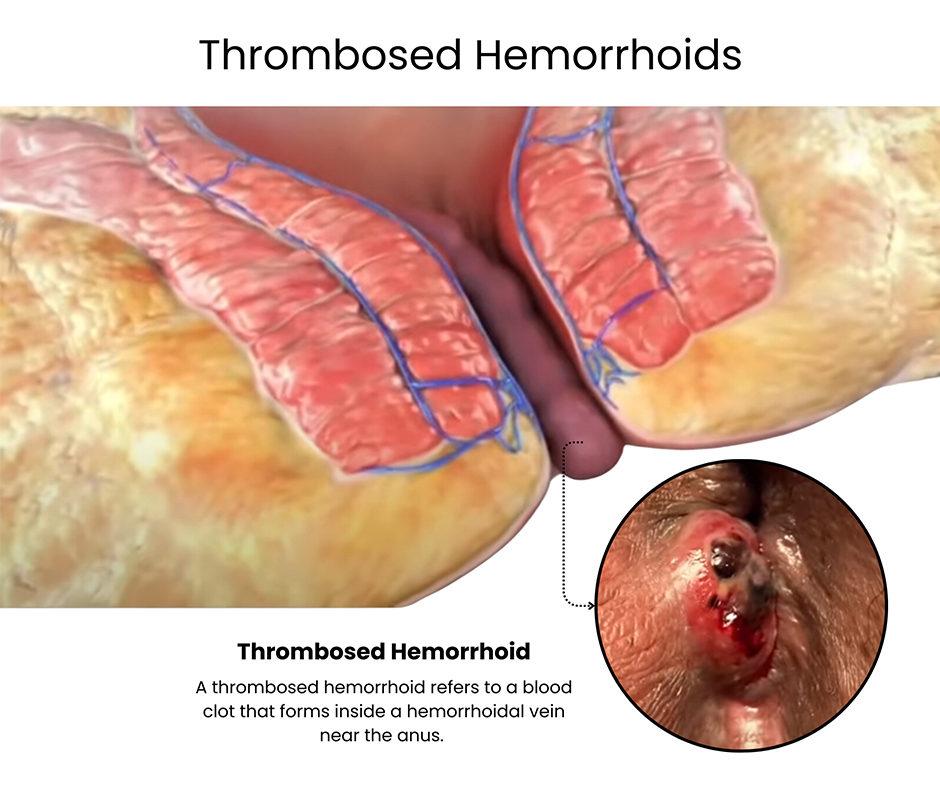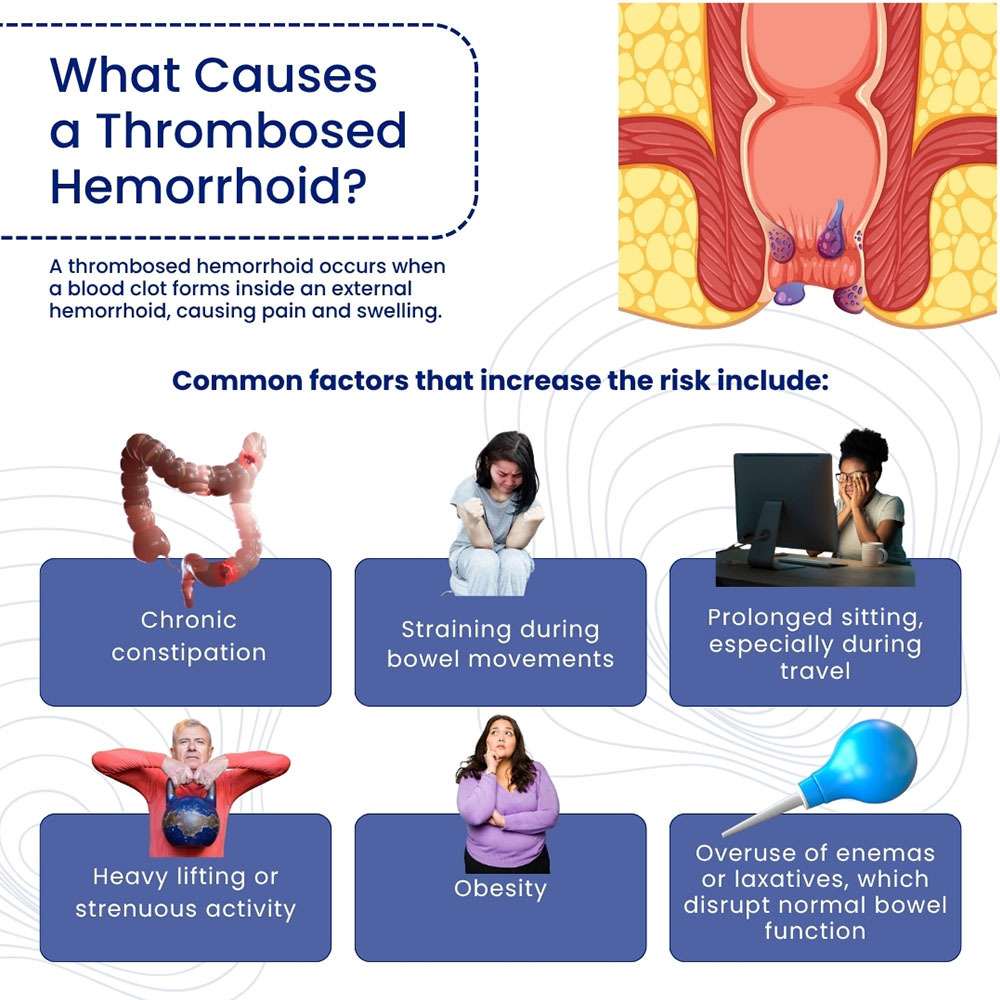You don’t want to wait until they develop blood clots and become severely painful. Hemorrhoids with clots are called thrombosed. They’re easily treated when you visit an experienced doctor. Blood clots are dangerous and should be treated as soon as possible. So even if you’ve had hemorrhoids in the past, get quick relief when you call today for an appointment. Our vein expert will choose the most appropriate treatment option for you, based on your diagnosis. While there are lots of ways to treat hemorrhoids like embolization or band ligation, not all of them are suitable for thrombosed hemorrhoids.
What Is a Thrombosed Hemorrhoid?

A thrombosed hemorrhoid refers to a blood clot that forms inside a hemorrhoidal vein near the anus. When blood vessels along the lower rectum become distended or swollen, it’s called a hemorrhoid. Hemorrhoids can be internal or external, but they’re a common problem that can cause itching and discomfort and may lead to bleeding. Large clots can cause significant pain.
If you experience persistent bleeding or painful hemorrhoids, have them evaluated by a highly experienced and reputable vein doctor. In Brooklyn, there’s no better choice than Dr. Sergei Sobolevsky at the Downtown Vein & Vascular Center in Brooklyn.
What Are the Top Symptoms of a Thrombosed Hemorrhoid?
External hemorrhoids can cause itching and irritation. If a hemorrhoid becomes thrombosed, blood pools and forms a clot, which then creates a lump that you can see and feel.
Some symptoms you may experience include:
- Swelling or lumps around the anus
- Severe pain and itching
- Inflammation
- Bleeding after a bowel movement
Your pain may get much worse when sitting, walking, standing or going to the bathroom. If a hemorrhoid becomes thrombosed, symptoms develop quickly and usually intensify in the first 48 hours.
What Causes a Thrombosed Hemorrhoid?
External hemorrhoids can be very uncomfortable, especially when they become thrombosed.
Factors that contribute to the development of a thrombosed hemorrhoid include:
- A history of constipation
- Straining when going to the bathroom
- Prolonged sitting, especially when traveling
- Heavy lifting
- Obesity
- Overuse of enemas or laxatives leading to poor bowel function

The reason a hemorrhoid becomes thrombosed isn’t always clear, but external hemorrhoids don’t always develop blood clots. Getting older can be a factor, since tissues weaken with age. Pregnancy increases pressure on veins and may increase the risk of thrombosed hemorrhoids. A diet that doesn’t include enough fiber can lead to hemorrhoids.
Can I Treat a Thrombosed Hemorrhoid at Home?
When problems with hemorrhoids start to develop, there are things your doctor may recommend that you can do at home.
Examples of home remedies for hemorrhoids include:
- Avoid constipation by increasing the amount of fiber in your diet
- Drink eight to 10 glasses of water every day
- Soak in warm water
- Use stool softeners
- Get a hemorrhoid pillow to reduce discomfort
- Avoid sitting on the toilet for more than a couple minutes
- Place ice packs on the area to reduce swelling
Some thrombosed hemorrhoids resolve on their own in about a week. Visit your hemorrhoids doctor before trying any at-home remedies just to make sure that you have hemorrhoids and not something else. But if you’re experiencing severe pain or bleeding, see your Brooklyn vein doctor right away.
How Is a Thrombosed Hemorrhoid Treated?
Thrombosed hemorrhoids usually develop unexpectedly, causing severe pain that worsens rapidly. They can be surgically removed during the first 72 hours after the onset of symptoms through a procedure done in your doctor’s office known as a thrombectomy.
Steps of this procedure include:
- Numbing the area using a local anesthetic
- Making an incision at the location of the hemorrhoid
- Draining the blood
- Applying a dressing
Stitches aren’t usually needed. If more than 72 hours have passed since a hemorrhoid becomes thrombosed, a thrombectomy may increase discomfort rather than reduce it. Your doctor may consider other surgical treatments, such as a hemorrhoidectomy.
When you visit Dr. Sobolevsky at the Downtown Vein & Vascular Center, he evaluates the severity of your hemorrhoids and recommends the most effective form of treatment for you. One of the safest and most effective means of treatment for hemorrhoids is embolization, a specialty of Dr. Sobolevsky. It’s a minimally invasive, in-office procedure that reduces your risk of recurring hemorrhoids, while preventing rectal trauma and incontinence. Symptoms improve almost immediately. Dr. Sobolevsky is known for providing safe, compassionate care for hemorrhoids and other vein conditions. Contact him for a consultation today.
Downtown Vein Treatment Center
480 Court Street, Ste 101
Brooklyn, NY 11231
(718) 787-5559


